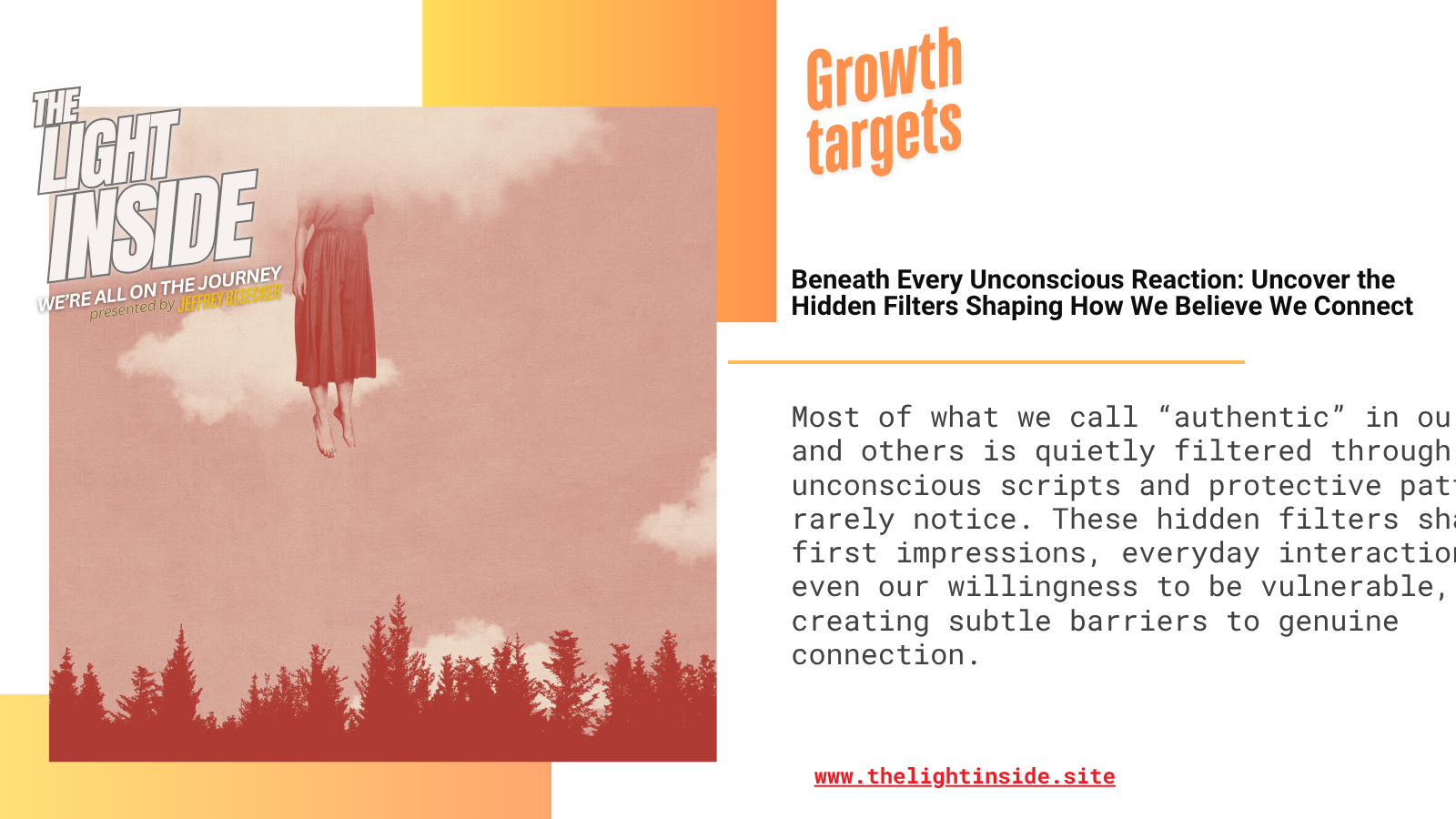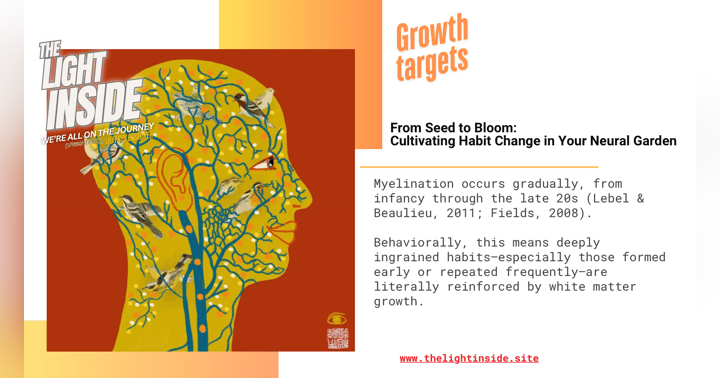Beneath Every Unconscious Reaction: Uncover the Hidden Filters Shaping How We Believe We Connect

Our personal truth is often far from being fully accurate or complete.
“What if everything we call ‘authentic’—our first impressions, everyday choices, and even the ways we connect with others—is quietly filtered through hidden scripts and protective moral imperatives, making our sense of authenticity as much a shield as a truth?”
Unconscious moral imperatives often act as hidden filters, shaping how we define and perform “authenticity” while quietly limiting our capacity for deeper human connection.
Because these imperatives are rooted in subconscious scripts, neural imprinting, and protective coping strategies, they influence our behaviors in ways we rarely recognize—leading us to mistake conditioned reflexes for genuine self-expression.
This creates a paradox: in striving to be “authentic,” we may actually reinforce defensive barriers that block openness, vulnerability, and integrative dialogue. Only by acknowledging these unconscious constructs can we begin to move beyond biased performances of authenticity and into more genuine, compassionate, and connective ways of relating.
Sometimes the first step in deconstructing our morals is recognizing that we’ve been unconsciously constructing them all along. The deeper challenge then becomes: can we hold both honest feedback and empathetic compassion with equal weight and respect?
Dissonance and Confabulation
Meta-cognitive dissonance often arises pre-emptively, showing up as denial, distraction, or deletion—protective filters that distort our projections and perceptions.
Let’s dig into how these unconscious moral imperatives — often hidden under the banner of “authenticity” — become avoidant coping strategies that quietly block growth and connection.
Meta-cognitive dissonance often triggers confabulation, the mind’s tendency to construct coherent narratives to explain or justify experiences, even when the underlying causes are unknown or unconscious.
When protective filters like denial, distortion, or deletion arise, confabulation fills the gaps, generating a subjective story about why we acted, felt, or judged as we did. These narratives then reinforce unconscious moral imperatives—internalized rules about what it means to be “authentic” or “good”—which often function as avoidant coping strategies.
For example: someone might insist that skipping the more vulnerable aspects of conversation is “just being true to myself,” when in reality the behavior shields them from discomfort or rejection.
Over time, these confabulated narratives stabilize, subtly altering perception and reinforcing the illusion of objective authenticity.
The result is a self-reinforcing loop: meta-cognitive dissonance triggers confabulation, confabulation justifies protective moral imperatives, and those imperatives filter our subjective sense of authenticity, quietly blocking both personal growth and deeper relational connection.
Analysis
In daily life, many people unconsciously adhere to internalized moral imperatives such as:
“I must always be true to myself.”
“I can’t betray who I really am.”
“I should never change for anyone else.”
On the surface, these sound virtuous, even empowering. Yet in practice, they often serve as protective constructs: they shield the self from vulnerability, discomfort, or the messy uncertainty of growth. What looks like principled authenticity can actually be a rigid defense against re-examining ingrained patterns, unresolved shadow material, or relational feedback.
Assessment
The paradox: these imperatives masquerade as commitments to authenticity but are actually avoidant strategies.
They reinforce identity rigidity by tethering “authenticity” to a static, idealized self-image rather than a fluid, evolving self.
They shut down feedback loops, because any suggestion of change feels like betrayal of the “true self.”
They perpetuate biases and blind spots — e.g., cultural, familial, or ego-based conditioning — under the guise of “this is just who I am.”
Instead of enabling growth, they create a psychological cul-de-sac where self-protection is mislabeled as integrity.
Illustration in daily context
Take a simple workplace or relational moment:
Someone receives constructive feedback — “You tend to dominate conversations, and it leaves others feeling unheard.”
A growth-oriented response would invite reflection: “Interesting, maybe my need to feel understood is overshadowing others. What’s behind that?”
But an unconscious moral imperative of authenticity reframes it as:
“This is just who I am. I speak my mind. If others can’t handle that, they’re not being authentic.”
The rigid construct blocks vulnerability (fear of being seen as insecure), preserves bias (equating dominance with honesty), and prevents connection (dismissing the relational impact).
Why our models of authenticity are overly reductive
Most popular culture definitions of authenticity simplify it into a binary: either you’re being “your true self” or you’re being “fake.”
Life us either scripted—or unscripted. Yet many if our core human processes are inherently scripted—both subconsciously and unconsciously.
Authenticity meaning: original ‘source’ or place of origin. Yet, how often are we truly the point of origin for any of our human responses—free of an external influence or source.
But in reality:
Authenticity is dynamic, not static. Our values, identities, and perspectives shift.
Authenticity can hide bias: we may unconsciously equate “authenticity” with comfort zones, cultural scripts, or ego defenses.
Authenticity requires self-transcendence, not just self-expression — the ability to examine whether what we call “authentic” is actually avoidance of vulnerability.
When models of authenticity stay reductive, they give people a moral shield to avoid deeper introspection, especially around unconscious beliefs and conditioned identity patterns.
✅ Uncommonly recognized point:
Much of what people defend as “being authentic” is actually an unconscious moral imperative to avoid perceived dissonance, reinforcing bias and blocking growth.
Genuine human existence isn’t about ‘rigid’ fidelity to a static self-image; egocentricism—it’s about flexible honesty, willingness to evolve, and openness to being reshaped by experience and connection.
Illustrative example:
When I walk into a first-time meeting, I often catch myself leaning on the old mantra: “Just go in unscripted, it’s authentic.” On the surface, it feels spontaneous and true, but the reality is more complex.
My default neural imprinting—shaped by past experiences, cultural norms, and protective coping—pre-orchestrates much of how I show up.
I anticipate outcomes, steer conversations toward “safe” topics, and subconsciously edit what I disclose to preserve my sense of self. In those moments, beliefs, values, and default judgments subtly filter my perception, creating parataxic distortions that make me think I’m being entirely genuine, when in truth I’m projecting a subtly unconsciously rehearsed version of the many aspects of my SELF.
Meta-cognitive dissonance quietly reinforces this: I deny or delete discomforting cues, convincing myself this behavior is “authentic,” while protective moral imperatives quietly block deeper vulnerability.
Contrast this with intentionally creating a small conversational framework. Even minimal preparation—deciding to ask questions that genuinely invite reflection or vulnerability—can disrupt these default scripts. By pausing to notice my anticipatory assumptions and the protective filters shaping my responses, I start to create psychological safety for both myself and the other person.
I can then ask—“what makes any version or aspect this concept of self ‘more’ or ‘less genuine’ and true?
A willingness to consider when, where, why, and how we are construct these narratives or ‘scripts’ can be quite telling.
Could it be that any one of them might hold valuable knowledge and some grain of relevant truth—depending in the dynamic contexts and situational factors we often experience?
Emotional attunement emerges not from unplanned spontaneity, but from conscious engagement: I’m able to hold curiosity and empathy alongside honesty, navigating discomfort instead of avoiding it. The difference is stark—where rigid “unscripted authenticity” triggers defensive projection, a structured yet flexible approach allows connection to deepen, adaptive co-relations to form, and true vulnerability to surface.
Coachable inquiry: What unconscious scripts might be guiding your first impressions, and how could pausing to notice them help you replace rehearsed strategies and defenses with more open, adaptive, and genuinely connective responses?
In the most simple example, we often imagine meeting someone for the first time: believe subconsciously it's unscripted or unplanned.
We cover topics at a surface level at first, saving deeper discussions for follow-ups. As conversations continue, we feel we naturally become more open and vulnerable. Ultimately, building genuine connection is an ongoing, never-ending journey.
What if many of our first impressions and everyday choices aren’t as spontaneous as we assume—but instead are guided by pre-written scripts from our default neural imprinting?
These unconscious “codes” shape affective forecasting, meaning we anticipate outcomes before they unfold, often falling into prescriptive or ‘rehearsed’ behaviors without realizing it.
Doxastic Reasoning and Parataxic Distortion
Our beliefs, values, and default unconscious judgments set the tone, filtering reality through doxastic reasoning and parataxic distortions—ways our minds bend facts to fit old patterns.
Doxastic Reasoning is the process of interpreting information primarily to support pre-existing beliefs, often ignoring contradictory evidence to protect one’s sense of self or core identity.
- Example 1: You automatically dismiss a colleague’s constructive feedback or inout as “unhelpful” because it challenges your self-image as competent.
- Example 2: You insist your political viewpoint is the only reasonable one, disregarding nuanced evidence that might suggest otherwise.
Parataxic Distortion occurs when we unconsciously project past relational patterns or unresolved emotional experiences onto current situations, distorting perception to protect unresolved psychological wounds.
- Example 1: You assume a new acquaintance or friend is judging you harshly because a parent was overly critical in your childhood.
- Example 2: You interpret a partner’s neutral comment as rejection, reflecting prior abandonment experiences rather than the present reality.
Both patterns serve as protective filters, maintaining stability for the psyche and its contextual, dynamic ego processes but often limiting vulnerability, adaptive learning, and genuine connection.
When dissonance arises, we unconsciously deny, distort, or delete conflicting information to preserve a coherent sense of identity.
In truth, much of what we call “authentic” expression might be a projection edited by these inherited scripts.
How might you become more aware of the unconscious scripts guiding your assumptions and first impressions—so you can pause, notice the distortion, and choose a more open and adaptive response?
Even in moments that feel unscripted, our interactions are often subtly choreographed by unconscious social and moral imperatives.
These imperatives emerge from pre-emptive beliefs and assumptions—scripts wired through culture, upbringing, and adaptive evolution—that guide how “appropriate” or “genuine” to their source we allow ourselves to be.
These primary patterns—doxastic reasoning and parataxic distortions—are fundamentally adaptive, functioning as internal guides that help us navigate complex social and environmental landscapes. By filtering information through pre-emptive beliefs and culturally or evolutionarily wired scripts, they allow us to anticipate threats, maintain psychological stability, and preserve core aspects of identity in the face of uncertainty.
For example: interpreting ambiguous social cues through past experience can prevent potentially harmful missteps, while favoring information that aligns with existing knowledge helps us make rapid, consistent decisions.
In this way, what may appear on the surface as merely bias or distortion is actually a survival-oriented mechanism: it creates a logical pathway for continued growth, learning, and safe engagement with the world, providing the scaffolding upon which more nuanced, reflective, and adaptive behaviors can later develop.
What seems like casual small talk is frequently shaped by protective filters that dictate how deep we go, what we disclose, and how vulnerable we permit ourselves to appear.
These subconscious scripts are inherently human, designed to keep us safe within social roles and identity structures, yet they can also be disingenuous—shielding us from uncomfortable truths that might challenge our sense of self.
In protecting our identity, we unconsciously edit, soften, or deflect realities that might otherwise bring genuine connection.
In Closing
Our sense of authenticity and the ways we connect with others are often quietly shaped by unconscious moral imperatives, default neural scripts, and protective coping patterns that filter what we disclose, how vulnerable we allow ourselves to be, and even how we interpret feedback or relational cues.
These hidden processes can make us believe we are fully “authentic,” when in reality much of our behavior is guided by rehearsed patterns designed to preserve identity and avoid discomfort.
By bringing awareness to these unconscious influences, we open the door to deeper self-understanding, more honest interactions, and genuinely integrative connection.
Take a moment to notice the scripts guiding your assumptions and first impressions—where in your body do you first notice these truths—and consider exploring them more intentionally, creating space to engage with yourself and others in a way that fosters adaptive curiosity, empathy, and vulnerability.
Coachable inquiry: What hidden scripts might be steering the depth of your conversations, and how might loosening them open space for more adaptive connection?
I’d love to connect and explore these unconscious patterns together, uncovering how they shape our ability to hold capacity, regulate our emotional responses—influence our choices, and connections.
Reach out or drop me you feedback!
Here are three peer-reviewed sources that validate the concepts discussed in the provided overview:
1. Parataxic Distortion and Its Impact on Perception
Sullivan's concept of parataxic distortion explains how individuals perceive others based on past experiences and unconscious biases, rather than on their actual present behavior. This aligns with the idea that unconscious scripts shape our interactions and perceptions, often leading to misinterpretations and limiting genuine connection.
2. Confabulation and Its Role in Cognitive Dissonance
Research on confabulation highlights how individuals construct coherent narratives to explain or justify experiences, even when the underlying causes are unknown or unconscious. This process can reinforce protective filters and moral imperatives, distorting our sense of rigid authenticity and hindering deeper connection.
3. Life Scripts and Their Influence on Behavior
Life script theory posits that unconscious life plans from childhood, influenced by early experiences, shape behaviors, emotions, and relationships throughout life. These scripts often function as protective mechanisms, guiding our actions and interactions in ways that may not align with our core selves.


